ANOVA
Analysis of variance tests differences among means by analyzing variance.
| Test | DV | Number of Groups | Type of Group |
|---|---|---|---|
| One Sample t-Test | Compares means | Compares a sample to the population | Population |
| Two Sample independent t-Test | Compares means | Compares two samples | Independent (unrelated) |
| Two sample dependent t-Test | Compares means | Compares two samples | Dependent (related) |
| Between groups ANOVA | Compares means | Compares two or more levels of an IV | Independent (unrelated) |
| Repeated Measure ANOVA | Compares means | Compares two or more levels of an IV | Dependent (related) |
| Mann-Whitney U | Ranked data or Not normally distributed | Compares two groups | Independent (unrelated) |
| Wilcoxon Match-Pair Signed-Rank test | Ranked data or Not normally distributed | Compares two groups | Depended (related) |
| Kruskal-Wallis One-Way ANOVA | Ranked data or Not normally distributed | Compares two or more groups | Independent (unrelated) |
| Friedman’s test | Ranked data or Not normally distributed | Compares two or more groups | Dependent (related) |
IV: independent variable
DV: dependent variable
One Way ANOVA
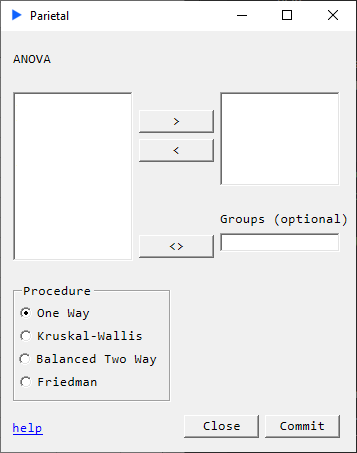
Description
Parametric test to compare means of multiple (three or more) samples.
: the central values of all data distributions are equal
: at least one of the central values is different
Assumptions:
- Dependent variables (more accurately its residuals) are normally distributed
- Variances are homogenous
- Independent samples
Returns
| Source | SS | DF | MS | F | P |
|---|---|---|---|---|---|
Example
The following dataset is taken from Introduction to Statistics by Lane et al.
Data Format 1:
Suppose our dataset is of the form:
| Group 1 | Group 2 | Group 3 |
|---|---|---|
| 3 | 2 | 8 |
| 4 | 4 | 5 |
| 5 | 6 | 5 |
We can run a one-way anova using:
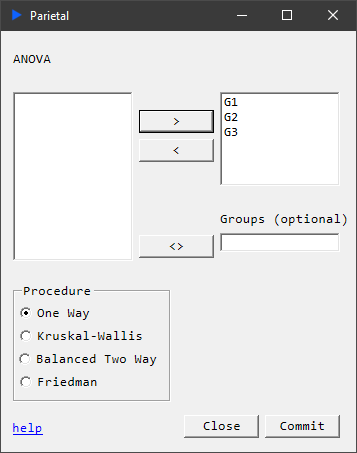
This produces the following table:

Data Format 2:
Another way of formatting the table for analysis is as follows. The advantage of this is that the number of elements per group do not have to be the same.
| Group | Y |
|---|---|
| 1 | 3 |
| 1 | 4 |
| 1 | 5 |
| 2 | 2 |
| 2 | 4 |
| 2 | 6 |
| 3 | 8 |
| 3 | 5 |
| 3 | 5 |

This produces the following table:

Example Reference: One-Factor ANOVA. (2021, January 10). Retrieved July 19, 2021, from https://stats.libretexts.org/@go/page/2175
Kruskal Wallis
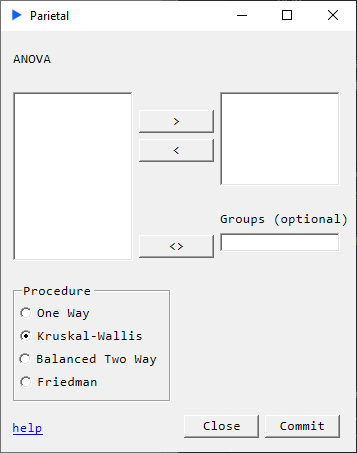
Description
Nonparametric test to compare means of multiple samples.
: the central values of data distributions are equal
: at least one of the central values is different
Assumptions:
- Continuous distributions
- Independent samples
Returns
| Source | SS | DF | MS | F | P |
|---|---|---|---|---|---|
Balanced Two Way ANOVA
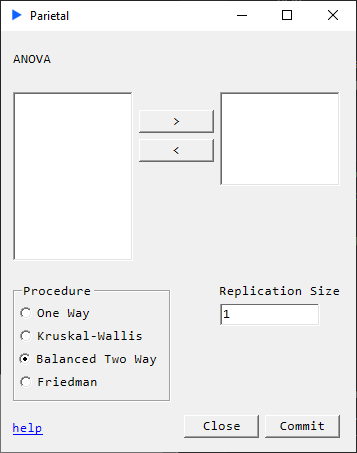
Description
Determines the difference between means in unrelated groups across two factors. This is an extension of the one-way ANOVA where there is only one factor.
Assumptions:
- Residuals must be normally distributed for each combination of levels of the independent variables
- Variances are homogenous
- Independent samples
Returns
Friedman
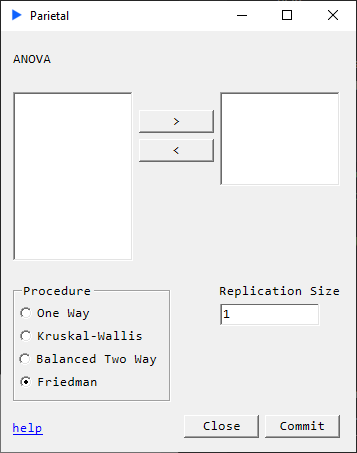
Description
Nonparametric alternative to repeated measures two-way ANOVA.
: the distributions are equal across repeated measures
: the distributions are different across repeated measures
Returns
- ANOVA table